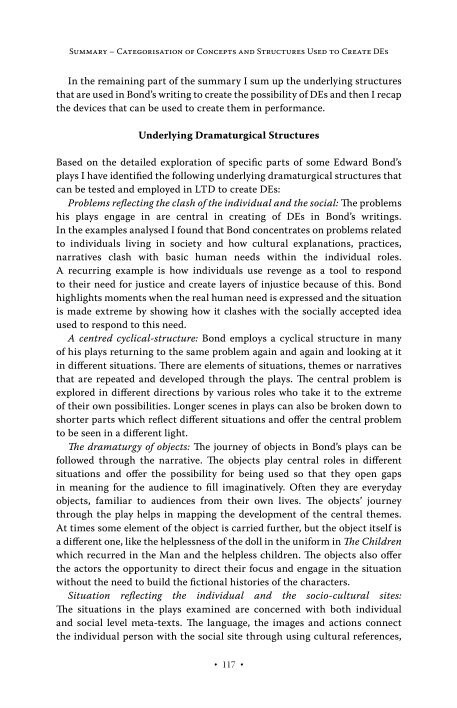

OCR
SUMMARY — CATEGORISATION OF CONCEPTS AND STRUCTURES USED TO CREATE DEs In the remaining part of the summary I sum up the underlying structures that are used in Bond’s writing to create the possibility of DEs and then I recap the devices that can be used to create them in performance. Underlying Dramaturgical Structures Based on the detailed exploration of specific parts of some Edward Bond’s plays I have identified the following underlying dramaturgical structures that can be tested and employed in LTD to create DEs: Problems reflecting the clash of the individual and the social: The problems his plays engage in are central in creating of DEs in Bond’s writings. In the examples analysed I found that Bond concentrates on problems related to individuals living in society and how cultural explanations, practices, narratives clash with basic human needs within the individual roles. A recurring example is how individuals use revenge as a tool to respond to their need for justice and create layers of injustice because of this. Bond highlights moments when the real human need is expressed and the situation is made extreme by showing how it clashes with the socially accepted idea used to respond to this need. A centred cyclical-structure: Bond employs a cyclical structure in many of his plays returning to the same problem again and again and looking at it in different situations. There are elements of situations, themes or narratives that are repeated and developed through the plays. The central problem is explored in different directions by various roles who take it to the extreme of their own possibilities. Longer scenes in plays can also be broken down to shorter parts which reflect different situations and offer the central problem to be seen in a different light. The dramaturgy of objects: The journey of objects in Bond’s plays can be followed through the narrative. The objects play central roles in different situations and offer the possibility for being used so that they open gaps in meaning for the audience to fill imaginatively. Often they are everyday objects, familiar to audiences from their own lives. The objects’ journey through the play helps in mapping the development of the central themes. At times some element of the object is carried further, but the object itself is a different one, like the helplessness of the doll in the uniform in The Children which recurred in the Man and the helpless children. The objects also offer the actors the opportunity to direct their focus and engage in the situation without the need to build the fictional histories of the characters. Situation reflecting the individual and the socio-cultural sites: The situations in the plays examined are concerned with both individual and social level meta-texts. The language, the images and actions connect the individual person with the social site through using cultural references, + 117 +
Szerkezeti
Custom
Image Metadata
- Kép szélessége
- 1831 px
- Kép magassága
- 2835 px
- Képfelbontás
- 300 px/inch
- Kép eredeti mérete
- 1.23 MB
- Permalinkből jpg
- 022_000014/0117.jpg
- Permalinkből OCR
- 022_000014/0117.ocr
Bejelentkezés
Magyarhu
